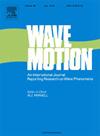A waveguide finite element model with geometric nonlinearity and orthotropy to analyse broadband vibrations in a reinforced radial tyre
IF 2.1
3区 物理与天体物理
Q2 ACOUSTICS
引用次数: 0
Abstract
In this work, we present a Waveguide Finite Element (WFE) model to predict the dynamic response of tyres, especially at high frequencies. The model developed here offers significant improvements over earlier ones as it accounts for geometric nonlinearities, material anisotropy, a multi-layered structure of the tyre, and prestress due to inflation pressure. Our formulation adopts a Total Lagrangian approach to establish the weak form of equilibrium equations, utilising the initial undeformed state as a reference frame. Further, we have linearised the problem using the Newton-Raphson iterative approach. The WFE method is then applied to formulate a linear eigenvalue problem corresponding to a given wavenumber. Forced vibration analysis is facilitated by using a proportional viscous damping model, enabling the assignment of damping factors to each natural mode while maintaining the symmetry of the undamped problem. The model developed was duly validated against results from a 3D FEA (Finite Element Analysis) model developed in commercial FEA software. Such validation exercises were conducted for both statically loaded and dynamically loaded tyres. Finally, the application of the waveguide finite element model is demonstrated through a case study involving vibration analysis of an inflated tyre. As part of this analysis, we carefully examined the FRF response and the dispersion diagram of the tyre. While the former helped us understand the tyre behaviour at low frequencies, the latter was found to be very useful for understanding wave propagation in the tyre at higher frequencies. Our investigation clearly shows that the WFE model developed in this work can be a very useful tool in designing tyres with better vibrational attributes speedily.
一个具有几何非线性和正交异性的波导有限元模型用于分析增强子午线轮胎的宽带振动
在这项工作中,我们提出了一个波导有限元(WFE)模型来预测轮胎的动态响应,特别是在高频下。这里开发的模型与之前的模型相比有了显著的改进,因为它考虑了几何非线性、材料各向异性、轮胎的多层结构以及由充气压力引起的预应力。我们的公式采用全拉格朗日方法来建立弱形式的平衡方程,利用初始未变形状态作为参照系。此外,我们使用牛顿-拉夫森迭代方法对问题进行了线性化。然后应用WFE方法来形成一个对应于给定波数的线性特征值问题。通过使用比例粘性阻尼模型,可以方便地进行强制振动分析,从而使阻尼因子分配到每个自然模态,同时保持无阻尼问题的对称性。开发的模型与商业有限元软件开发的3D有限元分析模型的结果进行了适当的验证。这种验证演习进行了静态加载和动态加载轮胎。最后,以充气轮胎振动分析为例,说明了波导有限元模型的应用。作为分析的一部分,我们仔细检查了轮胎的频响响应和色散图。前者帮助我们理解轮胎在低频时的行为,而后者被发现对于理解轮胎在高频时的波传播非常有用。我们的研究清楚地表明,在这项工作中建立的WFE模型可以成为一个非常有用的工具,可以快速设计出具有更好振动特性的轮胎。
本文章由计算机程序翻译,如有差异,请以英文原文为准。
求助全文
约1分钟内获得全文
求助全文
来源期刊

Wave Motion
物理-力学
CiteScore
4.10
自引率
8.30%
发文量
118
审稿时长
3 months
期刊介绍:
Wave Motion is devoted to the cross fertilization of ideas, and to stimulating interaction between workers in various research areas in which wave propagation phenomena play a dominant role. The description and analysis of wave propagation phenomena provides a unifying thread connecting diverse areas of engineering and the physical sciences such as acoustics, optics, geophysics, seismology, electromagnetic theory, solid and fluid mechanics.
The journal publishes papers on analytical, numerical and experimental methods. Papers that address fundamentally new topics in wave phenomena or develop wave propagation methods for solving direct and inverse problems are of interest to the journal.
 求助内容:
求助内容: 应助结果提醒方式:
应助结果提醒方式:


